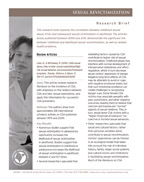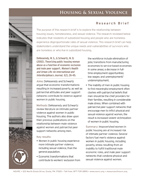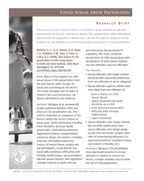Human Trafficking Research Brief
The purpose of this research brief is to review research on the relationship between sexual violence and trafficking (especially, but not limited to, sex trafficking) and shed light on gaps in existing research.
is to review research on the relationship between sexual violence and trafficking (especially, but not limited to, sex trafficking) and shed light on gaps in existing research.
The purpose of this research brief is to review research on the relationship between sexual violence and trafficking (especially, but not limited to, sex trafficking) and shed light on gaps in existing research.
is to review research on the relationship between sexual violence and trafficking (especially, but not limited to, sex trafficking) and shed light on gaps in existing research.
This research brief explores the  prevalence of sexual violence against individuals and communities who identify as lesbian, gay, bisexual, transgender, and queer (LGBTQ).
prevalence of sexual violence against individuals and communities who identify as lesbian, gay, bisexual, transgender, and queer (LGBTQ).
 This research brief reviews articles that explore the connection between childhood sexual abuse (CSA) and subsequent sexual victimization in adulthood. It demonstrates the significant link between childhood and adulthood sexual revictimization, as well as related health problems.
This research brief reviews articles that explore the connection between childhood sexual abuse (CSA) and subsequent sexual victimization in adulthood. It demonstrates the significant link between childhood and adulthood sexual revictimization, as well as related health problems.
Publish Date
2011
 This research brief explores the relationship between housing issues, homelessness, and sexual violence. The research reviewed indicates that residents of subsidized housing and people who are homeless experience disproportionate rates of sexual violence.
This research brief explores the relationship between housing issues, homelessness, and sexual violence. The research reviewed indicates that residents of subsidized housing and people who are homeless experience disproportionate rates of sexual violence.
 The purpose of this research brief is to synthesize prior research on risk and preventative factors for child sexual abuse (CSA) perpetration, while highlighting special offender populations.
The purpose of this research brief is to synthesize prior research on risk and preventative factors for child sexual abuse (CSA) perpetration, while highlighting special offender populations.
This brief reviews research on risk and protective factors related to sexual violence in later life.
This Occasional Paper is entitled Beijing and Beyond: Putting Gender Economics at the Forefront, Fifteen Years After the World Conference on Women. This paper demonstrates that, notwithstanding some advances since the Beijing Conference and the adoption of CEDAW, the UN member States still have not fully implemented their commitments to gender equity as an essential condition for sustainable economic and social development.
Research on juvenile sex offenders goes back more than half a century; however, little information about these young offenders and their offenses exists. This Bulletin draws on data from the Federal Bureau of Investigation’s National Incident-Based Reporting System to provide population-based epidemiological information on juvenile sex offending.
The majority of teens have been involved in a romantic relationship. The following brief, Telling It Like It Is: Teen Perspectives on Romantic Relationships, summarizes findings from focus groups that explored what teens themselves have to say about these relationships. Among the findings: